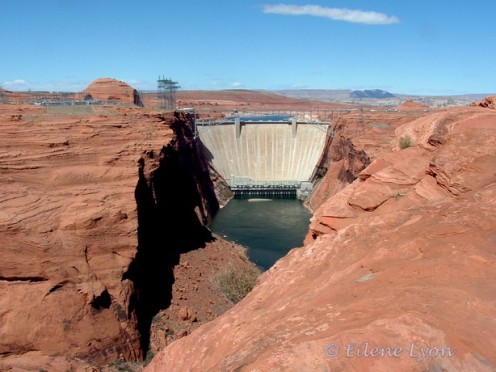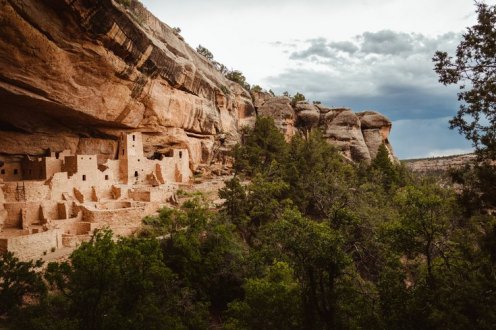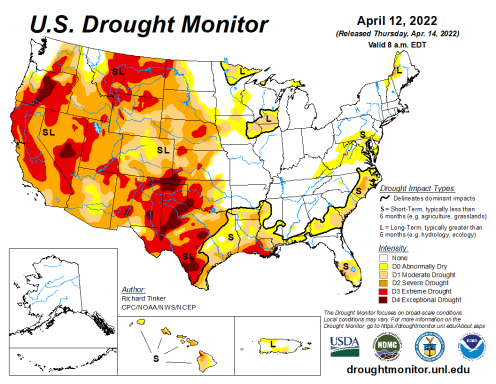By Eilene Lyon
“We know surprisingly little about vanished civilizations whose majesty and whose ultimate demise were closely linked to liberties they took with water.” – Marc Reisner, Cadillac Desert: The American West and Its Disappearing Water
It’s no secret that the southwestern United States is a dry place—and getting drier. We’ve entered our third decade of drought and there is no end in sight. The two largest reservoirs, Lake Mead and Lake Powell, stand at 32% and 24% of capacity, respectively. According to the Lake Powell Water Database, inflows to the lake so far this water year (at day 200) are 59% of average. The tracked upstream reservoirs are at 64% of capacity.

Spring runoff might improve those figures, but given that our snowpack in Colorado is roughly 92% of the median for 1991–2020, that’s a mighty big IF (as in “IF it rains sometime soon and in a good quantity”).
The population of the six states making up the region was 61.02 million at the 2020 census. That’s an increase of 12.58 million (+26%) since 2000. Every one of those states grew in population over that 20-year period. As water resources continue to become depleted, how will it change the flow of people into and out of the area?

The current drought seems to be mimicking that of 1271–1300 CE, a time when the Ancestral Puebloan communities of the Four Corners were abandoned, sites such as Mesa Verde, Chaco Canyon, Hovenweep, and Canyon of the Ancients. (We know about ancient droughts, thanks to the brilliance of tree-ring data. Obtaining good core samples is a difficult process, as I discovered during my internship at Mesa Verde NP.)
The changing climate nearly a millennium ago not only made agriculture nearly impossible, but food shortages appear to have led to violent upheaval, causing the survivors to scatter. Our understanding is necessarily theoretical, but the fact of these empty villages stand as testament. (Native tribes do not consider them “ruins.”)

Is this the fate that awaits the denizens of today’s Southwest? Will Phoenix, Las Vegas, and San Diego become ghost towns after a spate of violent altercations and mass death? It doesn’t seem too likely, but who really knows?
What is probable begins with agriculture—the number-one consumer of water. Already, almond groves in California are being ripped from the ground and replaced with less water-intensive crops. That’s just a start. Fields all over these states will be fallowed. Herds of cattle will shrink as grazing lands wither and become desertified—a process that’s been ongoing for over a century.

As agriculture is abandoned, more water will be available for urban areas, but where will all these people get their food? If California continues its trend toward becoming a net importer instead of exporter of food, is that a sustainable scenario? Or will people flee the region in a mass exodus?
I have no answers for all the questions I’ve raised here, but they bear thinking about, and developing plans for the most probable scenarios.
Feature image: Chaco Canyon National Park (E. Lyon 1988)
 P.S. As the drought continues, if you consider relocating, you might want to move to those places in WHITE in the map above.
P.S. As the drought continues, if you consider relocating, you might want to move to those places in WHITE in the map above.

A very sobering post.
LikeLiked by 2 people
It just astonished me that people keep moving to this region as water supplies dwindle. “Water’s for fightin’” is a true western theme.
LikeLiked by 2 people
It seems like more of the attitude that the earth will give us whatever we want just because we want it.
LikeLiked by 1 person
We do have trouble seeing past the short-term, at least in the U.S. It’s different in other cultures.
LikeLiked by 1 person
Very good post giving me much to ponder. Thank you for this
LikeLiked by 2 people
Hey, you live in the white (no drought) zone. It’s pretty different out here.🙂
LikeLiked by 1 person
True. I get four season weather, including rain and snow
LikeLiked by 2 people
We get rain and snow, but it comes to less than 16” of moisture a year.
LikeLiked by 1 person
That’s tough
LikeLiked by 1 person
We are on well water and I have to use it to keep my garden alive. We don’t have a lawn and grow mostly native plants. But I’m a sucker for flowers and a small veggie garden.
LikeLiked by 1 person
Wow. Such a large area effected.
LikeLiked by 2 people
I haven’t sought out such maps from 25 years ago, but I should. I would be interesting to see if the drought area is expanding.
LikeLiked by 1 person
Yes. That was my question.
LikeLiked by 1 person
Might be my next post in the series.🙂
LikeLike
Whenever I’ve been in Vegas I couldn’t shake the feeling that the whole place was living on borrowed time, water-wise. I like your advice to move the areas of the country that are not impacted by the drought.
LikeLiked by 2 people
Like the Reisner quote suggests, some of us live like water is an endless commodity, even in the desert. All the fountains, golf courses, and even reservoirs, are extremely wasteful. I think Vegas is in the running for future ghost town, for sure.
LikeLiked by 1 person
There are quite a few ways to mitigate for drought – fortunately mankind is much more aware of these now than they were in previous droughts!
LikeLiked by 1 person
There are, but we seem loathe to employ them. I’ve seen a lot of rangeland that will not recover in my lifetime, and probably not the next.
LikeLike
I live in an area in Alberta that was affected by the 1930’s ‘Dust Bowl’ Drought. Farm and range land practices today are considerably different! The same can be said for flood management since we live in a part of the province that experiences both!
LikeLiked by 1 person
The land conservation services in the U.S. has done a lot, too. It’s more relevant in the plains states, though.
LikeLiked by 1 person
An interesting article. Maybe we will have to leave the planet – those clouds look like spaceships!
LikeLiked by 2 people
Hahaha! Yes, I think they do. Reminds me of the bumper sticker: “Earth First! We’ll mine the other planets later.”
LikeLiked by 1 person
The increasing dryness is obvious even in our own county home in SW Colorado. Over 30 years the piñon pine tree die-off and increasing cactus population is clearly visible even to my untrained eye.
LikeLiked by 1 person
What a nightmare scenario. What have we done to our planet? And when will we really start doing something to at least slow the destruction caused by climate change?
LikeLiked by 1 person
More good questions that no one seems to want to answer – at least not among the governing class.
LikeLiked by 1 person
People want to keep moving to warmer climates, watering their yards, driving their gigantic grass-guzzling vehicles and eating lots of beef.
LikeLiked by 1 person
Live like there’s no tomorrow – that’s the American way!
LikeLiked by 1 person
Gas, not grass! Haha! Seriously, some changes in our lifestyles would make a big difference.
LikeLiked by 1 person
We visited this area in 2008 so I remember Lake Powell and the white ring where the water used to come up to. Drought is not a problem we have, but that doesn’t matter – we’re all on the same planet and will sink or swim together (to use an inappropriate metaphor given the subject)!
LikeLiked by 2 people
We might end up swimming in salt water!
LikeLiked by 1 person
As far as doomsday scenarios are concerned, this seems much too close for comfort.
LikeLiked by 1 person
If climate change can’t get people’s attention, regional drought doesn’t stand a chance. Denial is a river in Egypt, after all.
LikeLiked by 1 person
You’re right, sadly.
LikeLiked by 1 person
I don’t expect anything drastic will occur, at least not anytime soon.
LikeLiked by 1 person
I took a look at a Canadian drought map. We pretty much mirror you along the border by the prairies. It is rather worrisome.
LikeLiked by 1 person
As Margy commented, at least we have better processes in place to prevent another Dust Bowl. Still, as this sort of thing continues, agriculture will probably abandon some areas and repopulate (where possible) in areas with more rainfall. Unfortunately, we’ve put cities and towns in those areas.
LikeLike
Interesting post Eilene. The U.S. Drought Monitor looks pretty scary with over half of the nation in drought-like conditions. I guess I’d better quit complaining about our repeated soggy days we’ve had the last three Springs.
LikeLiked by 1 person
Too much dry, too much wet. Somewhere there’s a sweet spot!
LikeLiked by 1 person
Great and informative ❣️
LikeLiked by 1 person
Thank you!
LikeLiked by 1 person
You are most welcome ❤️
LikeLiked by 1 person